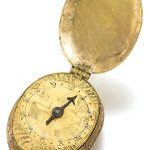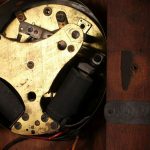Nicholas Vallin. The son of the Flemish clockmaker John Vallin (ca. 1535–1603), Nicolas became the leading clock- and watchmaker in London. Both John and Nicolas emigrated to England, probably shortly before 1590 and undoubtedly as the result of political troubles in The Netherlands. Both father and son died in the London plague epidemic of 1603. Reference: The Metropolitan Museum
WEIGHT-DRIVEN MUSICAL CHAMBER CLOCK DESCRIPTION OF CLOCK (OJC 30/3/2011) A weight-driven three train clock with verge and balance, two hands, striking the hours and playing music on each of the quarters. The frame and wheel work are largely in iron. The posted-frame movement is arranged in four tiers, supported by doric columns with entasis; The first (lower) tier houses the trains. The sides and rear are exposed but a gilded brass dial plate is set between front columns, engraved in an architectural design with perspective. Silvered brass chapter ring is engraved with roman numerals for hours and quarters, with quadfoil markings for the half hours and half quarters. Two concentric blued steel hands, for hours and minutes. Going train with two wheels, verge and balance. Striking train with two wheels, fly and countwheel. Music train with three wheels, fly and brass pin barrel. The second level houses the balance and is enclosed by engraved gilded brass panels. The third level houses thirteen bells which form the music carillon. This level is exposed on all sides. The fourth (top) level bears the large hour bell. Brass finials surmount the hour bell and each column. Architectural pediments are mounted on the front and two sides, each a triangular engraved gilded brass sheet set into an iron frame. TRAIN COUNTS Going; – Gt wheel 120 – Crown wheel 59/8 Striking; – Gt wheel 80 – 2nd wheel 96/10 – Fly 4 Quarters (musical); – Gt wheel 108 – 2nd wheel 96/12 – 3rd wheel 78/8 – Fly 6 DURATION CALCULATIONS (OJC 13/2/2008) Full train count of going train (including motion work); – Great Wheel Arbor (120T,12L. 1 rev/hour). 120 tooth wheel drives 8 leaf pinion on Crown Wheel Arbor. 12 leaf pinion drives 12 leaf pinion on ‘Lead- Off’ Arbor. – Crown Wheel Arbor (59T,8L. 1 rev/4 mins). 59 tooth crown wheel engages with verge. – ‘Lead-off’ Arbor (48T,72T,12L. 1 rev/hour). 48 tooth wheel drives 48 tooth wheel on Minute Hand Arbor. 6 leaf pinion drives 72 tooth wheel on Hour Hand Arbor. – Minute Hand Arbor (48T. 1 rev/hour). – Hour Hand Arbor (72T. 1 rev/12 hours). Going pulley diameter = 46mm (approx., measured in situ). Rope thickness 6.5mm (approx. under tension). Thus effective diam, 55.5m -> 165mm perimeter, i.e. 165mm line per hour on single line. For 9a.m. to 6 p.m., i.e. 9 hours. Addin 1/2 hour for inaccuracy, require 1.57m line. Add height of bracket, pulley & weight for total drop. Say 1.8m. ACTION OF MUSICAL QUARTER TRAIN (OJC 18/2/2008) There is a disc with fours pins behind the dial. This rotates once per hour with the minute hand. The pins lift a lever, which itself lifts another lever at the back of this movement. There are two detents attached to this, once which locates into recesses in the pin barrel (much like a countwheel) and the other which engages with either of two stops that are mounted on the ‘stop wheel’. The 108 teeth on the pin barrel wheel engage with an eight leaf pinion on the stop wheel arbor, i.e. the stop wheel rotates 13.5 times for every revolution of the pin barrel. Thus every quarter, the levers are lifted and the pin barrel runs and music is played, until the detent drops into a recess on the pin barrel, which allows the attached lever to obstruct a stop on the stop wheel causing the train to stop (abruptly). The length between recesses on the pin barrel are not equal, i.e. the length of music played at each quarter is different. These different lengths are more easily counted in terms of revolution of the stop wheel and are as follows; – 1st quarter – 1/4 rev of stop wheel. – 2nd quarter (half-hour) – 3 revs of stop wheel – 3rd quarter – 3/4 rev of stop wheel – 4th quarter (the hour) – 5 revs of stop wheel
Made by: Nicholas Vallin biography Date 1598
Reference: © The Trustees of the British Museum
Watch with alarm ca. 1600 Movement by Nicholas Vallin
he watch, which has a verge escapement, runs a little more than twenty-four hours per each winding, and originally it struck the hours in passing (a single blow on the bell at each hour).
Reference: The Metropolitan Museum
Nicholas Vallin A SIGNIFICANT ELIZABETHAN EARLY GILT-METAL OVAL VERGE WATCH CIRCA 1600 • gilt full plate movement, pierced and engraved balance cock, engraved plate decorated with foliage, rounded baluster pillars, fusee and gut line, ratchet and click set-up and large bow-shaped spring, later verge and balance • gilt dial with Roman numerals and half hour star-shaped markers, silver touch pins within chapter ring marking hours, single arrow hour hand, central engraving of seated cherub beside an hourglass with an elbow resting upon a skull • case front with engraved allegorical figure of Peace, case back depicts Justice, winding square, band engraved with decorative foliage • movement signed N Vallin length including pendant, 67 x 42mm
Sold for 27,500 GBP at Sotheby’s in 2015




